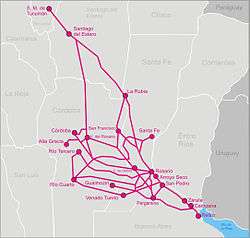Central Argentine Railway
The Central Argentine Railway (CA) (in Spanish: Ferrocarril Central Argentino) was one of the Big Four broad gauge, 5 ft 6 in (1,676 mm) British companies that built and operated railway networks in Argentina. The company had been established in the 19th century, to serve the provinces of Santa Fe and Córdoba, in the east-central region of the country,[1] although it would later extend its operations to Buenos Aires, Tucumán and Santiago del Estero.
| Central Argentine Railway | |||
|---|---|---|---|
 | |||
 Retiro station c. 1920 | |||
| Overview | |||
| Native name | Ferrocarril Central Argentino | ||
| Type | Private | ||
| Status | Company defunct; railway line active as FC. Mitre | ||
| Locale | Argentina | ||
| Termini | Buenos Aires Tucumán | ||
| Stations | Rosario Central [lower-alpha 1] Rosario Norte [lower-alpha 2] Córdoba Santiago del Estero | ||
| Operation | |||
| Opened | 1863 | ||
| Closed | 1948 | ||
| Technical | |||
| Track gauge | 1,676 mm (5 ft 6 in) | ||
| |||
History
Origins
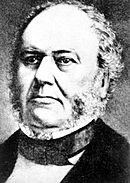
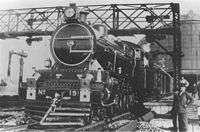
.png)
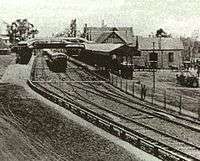
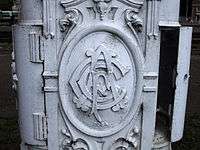
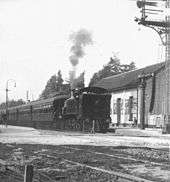
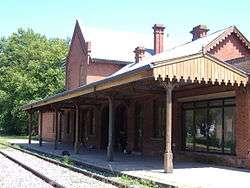
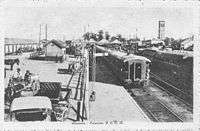
On 5 September 1854, American engineer Alan Campbell proposed to then President of Argentine Confederation, Justo José de Urquiza, to make a study for a possible railway line between cities of Rosario and Córdoba.
In November 1855 the report (written entirely in English) was presented in Rosario. Campbell had been the engineer in the New York-Harlem railway line and been hired by William Wheelwright to make a study for the Copiapó–Caldera line project in Chile.
The costs estimated by Campbell in the report, were the following:
| Description | Cost (AR $) |
|---|---|
| Excavations, ditches | 656,000 |
| Bridges, gutters | 153,000 |
| Paths, tracks | 2,673,000 |
| Machines and rolling stock | 350,000 |
| Stations | 280,000 |
| Administration, managing, engineers, fees | 300,000 |
| Dock of Rosario | 40,000 |
| Lands | 0 |
| Workers, rooms, freight | 70,000 |
| Reserve percentage (10%) | 452,200 |
| Total amount | 4,974,200 |
The distance estimated was 396 km and the costs were in Argentine pesos (GBP 1 = $5). The study revealed a cost of GBP 4,000 per mile built. A decree promulgated in April granted the company "the lands to build roads, docks, stations and stops, that will be given to the company in perpetuity and free of lines."
Construction
In 1863, the government of Argentina granted the company, led by engineer William Wheelwright, a concession to build and operate a railway line between the cities of Rosario (a major port in southern Santa Fe, on the Paraná River) and Córdoba (a large city near the geographical center of Argentina, and the capital of the province of the same name). The grant included a clause to populate the lands along and around the railway that were given to the company by the national state.
The construction works started in April 1863 with the establishment of the terminus in Rosario, at Rosario Central Station. The line was built as a 1,676 mm (5 ft 6 in) broad gauge railway. In September 1867 the line reached Villa María, Córdoba, and the works ceased. Minister Rawson expressed disagreement for the paralysis of the works while passengers also protested against poor conditions of the service. The works for the Rosario Central station and other intermediate stations had not begun. The company alleged that they could not continue the extension of the line until the pending lands were given.
In September 1867, the government authorized a new disbursement of $1,500,000 to conclude the pending works. Finally in March 1870 the railway reached the city of Córdoba and it was officially inaugurated by then President of Argentina Domingo Sarmiento on 13 April. The CAR was the longest railway system at that time and the first to join two provinces.
For 18 years the company did not built any tracks elsewhere so in 1888 the railway system still had 396 km of extension.
Progress
The company sent a commissioner to Europe to bring immigrants to form agricultural colonies, as required by the concession contract. They were settled first in Roldán, the first stop after Rosario, and then in San Lorenzo, Carcarañá, Cañada de Gómez and Tortugas.
In 1891 the CAR opened Fisherton Station in the west of Rosario, as well as a new branch entering Rosario from the southwest and a stop on said line (Eloy Palacios Station). Victoria station was also opened in 1891. Trains to Zelaya and Capilla del Señor departed from Victoria for the first time one year later. The CAR also installed the first crossbuck and manually-operated gates in the many level crossings existing by then.
The CAR absorbed a local company, the Santa Fe Western Railway ("Ferrocarril Oeste Santafesino"), in 1900. The lines handled by SFWR, which served the southwest of Santa Fe Province and the south of Córdoba (up to the city of Cruz Alta), were merged with those of the larger company, and the passenger services handled by Rosario Oeste station were transferred to Rosario Central station, while the former was renamed "Rosario Este".
In 1908, CAR was merged with another company, Buenos Aires and Rosario Railway, which served the Buenos Aires–Rosario line. The passenger services were unified and optimized: Rosario Central Station was left in charge of short and mid-distance services, while Rosario Norte Station was set aside for long-distance and express services. The fused company opened two new stops in Rosario, Parada Cruce Alberdi (present-day Patio Parada) in the north-center of the city, and Parada Golf (or Parada Links), in the western limit of the municipality, near today's Rosario Golf Club.
During successive years, several new stations would be built by the company in the Greater Buenos Aires, such as Beccar (1913), La Lucila (1933), Acassuso (1934) and Virreyes (1938).
In 1916, the Retiro-Tigre line was electrified, becoming the first electrified railway system of South America. New British Thomson-Houston (BTH) multiple units were acquired to run on the line.[2]
The CAR also ran several express services to the North of Argentina, such as El Rápido (inaugurated in 1910) that was also the first express train of Argentina. That service could reach the city of Rosario in about 5 hours. In 1925, the new Campana station, located nearer the center of downtown, was opened. Another long-distance service was El Panamericano, inaugurated in 1929, that reached Tucumán and allowed passengers to transfer Ferrocarril Central Norte trains to cross the border to Bolivia. One year later, the Estrella del Norte (a train that would become a classic) joined Buenos Aires and Tucumán, towed by W G Armstrong Whitworth & Co PS11 locomotives.[2]
In 1931, the CAR electrified the Retiro-Villa Ballester services, acquiring a new fleet of Metropolitan Vickers electric multiple units to run on the line. That same year, the Belgrano-Tigre section (known as "Tren del Bajo" - currently "Tren de la Costa") was also electrified.[2]
The company continued its expansion. Between 1935 and 1940, already past the "golden age" of Argentine railways, Rosario Central Station managed seventy daily train services, with an annual average of 438,000 passengers.[3]
By 1948, the following companies had been added to CAR railway network:
| Former company | Province/s covered | Acquired |
|---|---|---|
| BA Northern | Buenos Aires | 1888 |
| BA & Rosario | Buenos Aires, Santa Fe, Córdoba, Sgo. del Estero, Tucumán | 1902 |
| Santa Fe Western | Santa Fe | 1900 |
Nationalization
British railway companies operating in Argentina, including CA, were nationalised in 1948 by the Juan Perón administration. Ferrocarril Central Argentino took over the northern section of Ferrocarril Rosario y Puerto Belgrano and then became part of the state-owned Ferrocarril General Bartolomé Mitre. The railway system as a whole was reconfigured and this meant the closure of many stations; in the case of the Ferrocarril Mitre, only the original Rosario Central station was left to handle passengers.
In popular culture
At the end of the 1880s a group of CAR workers used to meet to play a form of "football" in the vacant lands located near the Alberdi Avenue. In 1889 Christmas almost 70 people met in a bar with the purpose of establishing a football club. British citizen Thomas Mutton suggested the name "Central Argentine Railway Athletic Club", which was approved. At the beginning, the club only allowed employees of the CAR to be members of the institution.[4]
In 1903, the club changed its name to "Rosario Central".[4] It would later become one of the most prominent clubs in the city, along with arch-rival Newell's Old Boys.
See also
- William Wheelwright, CAR owner
- Henry Herbert Loveday, general manager of the CAR, 1895 to 1910
- Rosario Central, football club founded by CAR's employees
Notes
- Original terminus.
- Added to CAR when the company acquired the Buenos Aires and Rosario Railway in 1902.
References
- "Historia de los Ferrocarriles de Rosario" [History of Rosario's Railways]. Asociación Rosarina Amigos del Riel (in Spanish). Archived from the original on 16 September 2009.
- Bernasconi, Ariel (2012). Historia del Ferrocarril al Norte del Gran Buenos Aires: Ferrocarriles Mitre y Belgrano (in Spanish). Dunken Editorial. ISBN 978-9870257691.
- "Rieles que corren sobre la memoria y el porvenir". La Capital (in Spanish). 10 April 2005. Archived from the original on 11 April 2005.
- Nuestros orígenes on Rosario Central website, 16 Apr 2017
- Lewis, Colin M. (1983). British Railways in Argentina 1857-1914: A Case Study of Foreign Investment. Athlone Press (for the Institute of Latin American Studies, University of London).
External links
| Wikimedia Commons has media related to Central Argentine Railway. |
